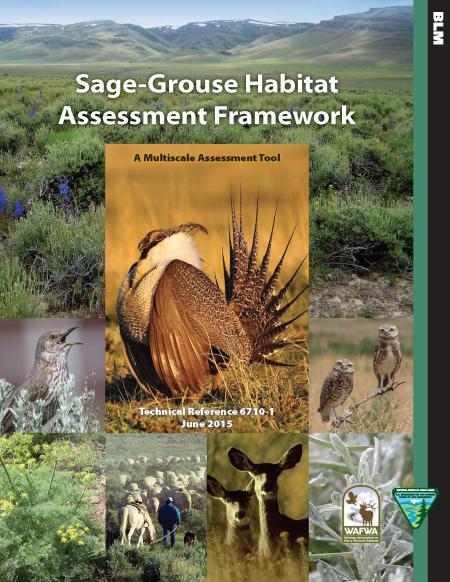Sage-Grouse Habitat Assessment Framework: A Multiscale Assessment Tool

[Publication released June 2015 with corrected errata]
The “Sage-Grouse Habitat Assessment Framework” (HAF) was conceived by several managers in the early 2000s. They assembled a diverse group of habitat specialists and sage-grouse experts from state, federal, and nongovernmental organizations to develop this habitat evaluation tool. In 2006, the “Greater Sage-grouse Comprehensive Conservation Strategy,” published by the Western Association of Fish and Wildlife Agencies, highlighted the development and implementation of the HAF. That strategy outlined a number of objectives for the HAF, which included a temporal and spatial method for evaluating sagebrush habitats for sage-grouse suitability at various landscape scales. The HAF is a cornerstone of the habitat monitoring component of the sage-grouse adaptive management strategy.
Over the past several years, the BLM has developed a number of tools to help manage the public lands on a landscape basis. These tools include creating the capacity to synthesize large amounts of geospatial information to help the BLM and our partners develop a shared understanding of regional trends and identify adaptive management and development opportunities.
The BLM is implementing this landscape approach in the Greater Sage-Grouse planning initiative, western solar plan, national cohesive wildland fire strategy, regional mitigation, and other major initiatives. Incorporating the necessary adaptive management actions and understanding the success of these initiatives will require a coordinated approach to monitoring and assessments so information about multiple resources at multiple scales can be easily integrated. Thus, the HAF is timely as it fills the need for a multiple-scale, sage-grouse habitat assessment tool that can be easily integrated into the BLM landscape monitoring approach.
The HAF establishes indicators to determine the status of sage-grouse habitat needs at multiple scales and for seasonal habitats. The results of these assessments will provide the necessary information to evaluate whether the BLM managed lands are meeting the sage-grouse land health habitat standard. Since the HAF assesses habitat needs at multiple scales, various datasets are needed for the analysis and assessment. To this end, the editors of the HAF coordinated with the BLM assessment, inventory, and monitoring (AIM) team to ensure the data required for the HAF indicator values are consistent with information currently being collected as described in “BLM Core Terrestrial Indicators and Methods,” Westwide monitoring efforts, and grass-shrub stewardship efforts. This coordination between HAF and AIM efforts addresses one of the critical monitoring challenges in the BLM today—field capacity to complete the monitoring data collection.
To assess monitoring capacity and propose options to resolve this issue, the BLM initiated a review of its monitoring practices in 2006. The results of this survey, as discussed in “The Bureau of Land Management Assessment, Inventory, and Monitoring Strategy for Integrated Renewable Resources Management,” indicated the need to coordinate and integrate monitoring activities and implement a data management strategy to eliminate redundant and duplicative data collection activities. The principles necessary to accomplish this integrated monitoring approach are described in BLM’s “AIM-Monitoring: A Component of the BLM Assessment, Inventory, and Monitoring Strategy.” When applying the principles of AIM monitoring to the HAF, field offices can minimize additional monitoring workloads. Applying these principles also creates opportunities to enhance national data layers and meet one of our primary goals of integrating monitoring activities: to collect data once and use it many times.
